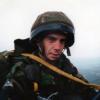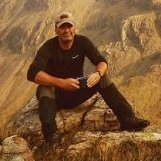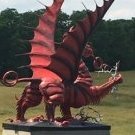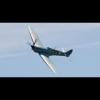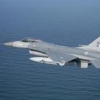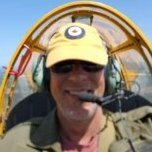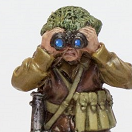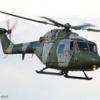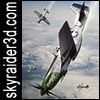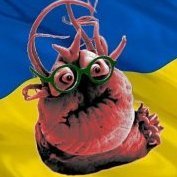Search the Community
Showing results for tags 'Battle of Britain'.
-
The Supermarine Spitfire is one of a handful of aircraft to have passed from history into legend. Its good looks helped (good looks often do) --- the curve of a Spitfire's wing might well stand for an essence of beauty in the ruminations of some Romantic esthete. It is the Spitfire that is the emblem of the Battle of Britain, the iconic mount of 'the Few' who delivered the first solid check to Nazi arms, and it does no good to point out Hawker's Hurricane did more of the heavy lifting, or that the effectiveness of the Me 109 was greatly hampered by limited range, and at times by escort deployments mandated more for boosting the morale of bomber crews than for their combat utility. When the legend becomes fact, print the legend, so the saying goes, and don't bother arguing. Just about every modeller feels impelled to do a Battle of Britain Spitfire sometime, and this model of Spitfire Mk Ia serial R6915 is mine. Spitfire Mk Ia serial R6915 is preserved at the Imperial War Museum, albeit as it appeared during the twilight of its career in an Operational Training Unit. This aeroplane, however, began its active service career just as the Battle of Britain commenced. It was built to a contract let shortly before the war began, and on July 11 1940 was delivered to No. 6 Maintenance Unit. On July 21, R6915 was received by 609 (West Riding) Squadron, an old Auxiliary Air Force formation based then at Middle Wallop. The aircraft was assigned to B Flight's Blue Section, and marked as PR-U. Several pilots flew R6915 PR-U in its early days with the squadron, but by late August, this machine became the favored mount of a Pilot Officer with the striking name of Noël le Chevalier Agazarian. Noël le Chevalier Agazarian was one of four sons and two daughters born to an Armenian electrical engineer and his wife, a genteel Frenchwoman. After the Great War, she purchased a surplus Sopwith Pup airframe that was installed in the garden of their London residence as a children's plaything. Which may account for the unusual degree of 'air mindedness' among the Agazarian brood, for four of them when grown took up aviation. Noël's younger sister Monique was a ferry pilot for the Air Transport Auxiliary during WWII, and afterwards became a prominent authority on simulator training and instrument flying. Their eldest brother, Levon Berdj Agazarian, joined the RAF and served in the Far East, flying Thunderbolts from Calcutta at the end of the war. Another of the brothers, Jack Charles Agazarian, joined the RAF, but during his training was recruited into the Special Operations Executive for service as a radio operator in France, where in 1943 he was betrayed into Nazi hands under circumstances which on their face are none too favorable to MI-6 (see note below). Known as 'Aggie' to his friends, Noël le Chevalier Agazarian proved to be quite an athlete in his school days, excelling at rugby, swimming, and boxing. He was denied entry to Trinity College by its President, with the comment that "In 1911, when the last coloured gentleman had been at Trinity, it had really proved most unfortunate." Noël was accepted at another Oxford school, Wadham College, in 1935. While studying law Noël kept up his championship caliber boxing, and joined the Oxford University Air Squadron, part of the Royal Air Force Volunteer Reserve. Here he met and became good friends with another aspiring pilot, Richard Hillary, who in his war-time memoir The Last Enemy (see note below) described Noël Agazarian as an extremely intelligent fellow with 'a pleasantly ugly face' who seemed a bit bewildered at finding himself to be such a fine athlete instead of a scholar. Early in 1939, the reservists of the Oxford Squadron were called up for active training at Lossiemouth. Agazarian and Hillary, along with several others, coalesced into a clique who referred to themselves as 'the longhairs', and plagued the RAF sergeants in charge of their initial training by their studied indiscipline. On completion of their flight training, Agazarian and Hillary both were disappointed to be assigned to Army Cooperation School at Old Sarum. There they flew exercises on obsolete Hawker Hector biplanes (one of which Noël crashed without injury to himself) and on the standard service type, the Westland Lysander. When their class at Old Sarum concluded in June, 1940, the RAF was bracing itself for an impending aerial onslaught by the Luftwaffe, and almost all graduates of the Army Cooperation School were assigned to Fighter Command. Noël le Chevalier Agazarian joined 609 Squadron in July, and soon showed himself a good fighting pilot. By mid-August, he had been credited with destroying three German fighters in air battles over naval installations on the south coast. Noël was flying PR-U R6915 on August 25, when he was credited with a fourth German fighter, an Me 110. From then through the end of September he flew this machine, being credited with two more fighters confirmed and two bombers as probables. On two occasions while attacking bombers, PR-U R6915 took damage from their defensive fire that forced Pilot Officer Agazarian to make a hurried landing, once with a bullet through the Merlin engine's oil sump, and once with a bullet through its glycol coolant tank. Both these, being in the lower part of the aeroplane's nose, were particularly vulnerable to well-aimed fire from a gunner directly attacked. PR-U R6915 was not flown by Pilot Officer Agazarian on its last sortie for 609 Squadron, but instead by Flying Officer John Dundas, considered a leading 'ace' at the time. Engaged with an Me 110, R6915 was struck by cannon shells, and the damage was beyond what a squadron workshop could cope with. The aeroplane was sent to a Civilian Repair Unit at Crowley on October 14, where it would remain till December. Noël le Chevalier Agazarian requested a transfer to North Africa in December, and was assigned to 274 Squadron there in January, 1941. Flying a Hurricane in support of 'Operation Brevity', he was killed on May 16. Spitfire Mk Ia R6915 had emerged from the repair shops and been delivered to 602 (City of Glasgow) Squadron in late January, 1941. With the new Spitfire Mk V coming into service, in July R6915 was relinquished to an Operational Training Unit, 61 OTU. R6915 then commenced to shuttle between various training units and repair facilities till summer of 1944, when it went into storage at Cardiff. From there, it was struck off RAF charge to the Imperial War Museum for static display in 1947, where it exists today. This model is built from the 'old tool' Airfix Spitfire I/II in 1/72. It was recommended back when I bought it as having better shape to the wing than the Tamiya offering, and Airfix was at the time putting out a 50th anniversary re-issue of the kit, the first one it had put on the market, which like the original came in a bag, not a box, and was moulded in bright blue plastic. I built the kit to OOB standard, with panel lines scribed and pilot figure employed. National markings are from an old Techmod sheet, ID codes from what remains of a Fantasy Workshop sheet. Wife printed up the serials. I doubt many of these are going to be built up nowadays, with the excellent new tooling available, but it went together well, and I think still does the business of making a decent miniature Battle of Britain Spitfire. When I chose PR-U R6915 as a subject for my model, I had no idea what lay behind the machine. I was simply looking through profiles in an old Aircam number for a Spitfire that had been in the thick of things in the Battle of Britain, whose codings could be replicated with decals I had on hand. Looking into operations of 609 Squadron, and refreshing my memory of Spitfire development and service, led to the discovery this machine was preserved in the Imperial War Museum. Reading the museum's 'History Note' for R6915, the name Noël le Chevalier Agazarian leapt out as something that just might be worth a closer look. Doing so led not only to a good deal of information about the gentleman, but to other stories his touched on, such as the skein of betrayals which caught up his brother Jack in France, and the painfully-won celebrity his friend Richard Hillary briefly enjoyed. I have prepared a note on each of these gentlemen, presented below in separate posts. It would be churlish to present here no detail concerning the career of Noël's sister Monique, but I can do no better justice to her than was done in her obituary in The Independent, written by someone she taught to fly, who considered her both mentor and friend.... https://www.independent.co.uk/news/people/obituary-monique-agazarian-1499214.html
- 10 replies
-
- 26
-

-

-
- Battle of Britain
- Spitfire
-
(and 1 more)
Tagged with:
-
I got the Galland Eduard Bf109E and had a think about the subject. I saw the Possum Werks decals that covered the dogfight that ended in the demise of Luftwaffe top scoring pilot Maj Helmut Wick, Flt Lt John Dundas, his wingman PO Paul A Ballion. Perfect, I thought, 2 subjects in 1 go, I click buy.....then I looked at the date of Dundas'/Wicks' final battle....28 Nov 1940......after the official battle dates....not wanting to feel the wrath of the GB moderators, I looked at other options and with Helmut Wick he was promoted to Major just before the end of the battle, its debatable if his aircraft was repainted by 30 Oct.... So I sourced some other decals of his aircraft Wr 5344, before his promotion. He was the leading Luftwaffe ace the day he died, there are lots of old black and white pics of his aircraft, so thought I'd give it a go. Plenty of history here: https://en.wikipedia.org/wiki/Helmut_Wick https://www.luftwaffe.cz/wick.html Never built Eduard, so any tips on this kit appreciated - will be built in flight so I have looked closely at the instructions ref the engine cover! Never done any mottling before so had a play over the weekend. The mottle on Wr5344 is really tight and what I would call 'dirty' so a sponge seems to be the best approach as per around the hole on the F111 wing! Nice 1/32 build here: https://forum.largescaleplanes.com/index.php?/topic/71809-eduard-bf-109-e-4-major-helmut-wick-1940/ http://falkeeins.blogspot.com/2009/12/helmut-wick-his-me-109-wnr-5344.html https://www.asisbiz.com/il2/Bf-109E/JG2-Stab/pages/Messerschmitt-Bf-109E4-Geschwader-Stab-JG2-Helmut-Wick-France-Oct-1940-0A.html Hope fully an interesting subject.
- 25 replies
-
- 10
-

-
- Bf109E-4
- Helmut Wick
-
(and 1 more)
Tagged with:
-
I had an old tool Tamiya Spit, which seems relatively straightforward so I looked for decals as the originals are no good. I saw the Possum Werks decals that covered the dogfight that ended in both Dundas, his wingman PO Paul A Ballion and Maj Helmut Wick, Luftwaffe top scoring pilot and Group Commander of JG 2's demise. Perfect, 2 subjects in 1 go, I click buy.....then I looked at the date of Dundas' final sortie....28 Nov 1940......after the official battle dates....not wanting to feel the wrath of the GB moderators, I looked to use the decals as much as I could...no records I could find of Dundas flying X4586 or R6631 before 30th Oct so counted out both on the sheet. With Helmut Wick he was promoted to Major just before the end of the battle, but who knows if his aircraft was repainted by 30 Oct.... I digress - I looked at the records of aircraft that John Dundas to decide on an aircraft to model. One that stuck out was R6915, Dundas flew it as PR-U on 9 Oct and claimed a Bf110 probable kill, as well as being injured in the leg by a cannon round. He was then to be awarded the DFC. The aircraft is still around on display in the Imperial War Museum in London. ''Eleven days later Dundas claimed a probable victory against a Bf 110, after a battle with German aircraft six miles north of RAF Warmwell at 16:30. Despite firing a 12–14 second burst at the enemy fighter, he did not see it crash. During the battle Dundas was hit in the leg when a cannon round exploded in his cockpit, but flew again the next day. The Spitfire Dundas flew that day, R6915, still exists, having been preserved by the Imperial War Museum. By 9 October 1940, his score stood at 10 and he was award the Distinguished Flying Cross.'' Using the various sets I think I can get the right decals. Any pearls of wisdom ref the old tool Tamiya kit build please let me know - should it be the 'blown' cockpit? Also any more specifics about R6915/PR-U ? Kit - pilot does seem quite big compared to the airfix and Fujumi characters! Montex masks and decals Build research and plan! Got the bits off the sprue and cleaned up No head armour so I grabbed the airfix part and some plasticard to replicate! Nor perfect but hey it will do, will have the pilot in and hood closed Primed using Stynlrez - thought I would try it....bizarre put 30 psi through my Iwata Neo .3 needle, but it came out ok then clogged up and was a bit messy cleaning up.....results are good, but I do like the Mr Paint Laquer pre mixed or Mr Surfacer 1500...Will prime the prop and pilots in white for ease. As I have copious builds (see more on Maj Wick to come!) mt plan is to get all the bits off the sprues, prime, then paint interiors/crew together to save time, paint and airbrush cleaning! Things will then progress as whatever pace takes my feelings towards various subjects.... Any top tips v welcome ref this old tool and subject matter!
- 35 replies
-
- 9
-

-
On this, the 80th anniversary of the start of the Battle of Britain, I can't resist sharing this one. It actually dates from Easter 2010. It was my then 10-year-old son's entry for his school Easter Egg craft competition (which he won). I helped him with some cutting and sticking but otherwise it's his work. (He's a great bearded brute now, not modelling nowadays, too interested in the stuff 20 year lads are interested in...)
-
My next build continues with Erprobungsgruppe 210 - this time I want to build a Bf110D. I have no link to this other than my mother lives in Southampton, over which the aircraft was targeting the Supermarine works on the night of 24th Sept 1940. Interestingly one of my other builds, a Spitfire flown by Crelin Bodie, is mentioned in my main reference source for the build, Bombsites over Britain, by John J Vasco. His Sqn, 66 Sqn RAF, engaged 3 x Bf110 over Aldebugh, downing 1 x Bf110D. This build will be of Bf110D-0 of the 1st Staffel, Wr 2284 coded S9 + HH. I will be also using the 1/72 build that @Stew Dapple completed back in 2014 as my paint reference etc as he'd done some previous research that showed a slightly different approach than the decals set. The aircraft was hit by anti aircraft fire that night and crashed into the channel. The 22 year old pilot, Lt Ulrich Freiherr von de Horst and 24 year old W/T Op, Ogefr Franz Ollers were listed as killed in action, their bodies never recovered. Ogefr Ollers would have celebrated his 25th birthday 2 days later. The Luftwaffe list the aircraft as shot down by fighters, although there are no traceable claims. Sold as new, when I opened the box there are signs of a few scratches, maybe sanding and copious notes on the instructions - thats E Bay for you! Should be fine though. Have some Montex Masks - didn't fancy that masking task ! @Stew Dapple - you mention some tinkering with the personal marking/unit marking on your thread, can i ask what that was? I have not done any WW2 Luftwaffe camo before, so plan a bit of practice on a paint mule. I have Mr Paint paints, but not sure it will work with a stipple brush etc, also have Mr Color that I may be able to thin to allow this. Any top tips on mottling appreciated - one of my builds will need real tight mottle that an airbrush just won't do....
- 50 replies
-
- 7
-

-
- Bf110
- Battle of Britain
-
(and 1 more)
Tagged with:
-
Kit: Tamiya 1/48 Spitfire I Decals: Victory Productions “Aces of the Empire” Here’s my entry for the group build The subject is Spitfire I R6893 “KL-T” 54 Sqn, based at Hornchurch in Summer 1940. This aircraft was regularly flown by Pilot Officer Colin Gray and he recorded a number of kills whilst flying this aircraft. First, the box and sprues And the profile from Victory Productions
- 130 replies
-
- 13
-

-
- Battle of Britain
- Tamiya
-
(and 1 more)
Tagged with:
-
My next build is the 1/48 Airfix Hurricane Mk1. I have some P Maks and decals for serial/Sqn Codes to model 249 Sqn Hurricane P3616 GN-F I read the book 'Gun Button to Fire' by Tom 'Ginger' Neil, who was a Pilot Officer and flew with 249 Sqn during the battle. He loved his Hurricane, P3616 coded GN-F. Whilst on a days leave, it was flown by another pilot, Pilot Officer Martyn Aurel King. Sadly he was shot down and killed, having bailed out but suffering a collapsed parachute. PO Martyn Aurel King He is buried in All Saints' churchyard, Fawley, Hampshire For his actions during this engagement in which PO King was KIA, Fl Lt Nicholson of 249 Sqn was to be gazetted for the only VC awarded to aircrew for actions in the battle. http://ww2today.com/16th-august-1940-flight-lieutenant-nicolson-wins-v-c Fl Lt Nicholson VC So I looked into the history, to find an interesting link. PO King was born in West Mersea, 15 minutes down the road from where I live in Colchester. Looking further into it, it became apparent that it is likely that PO King was the youngest serving RAF pilot in the battle and almost certainly the youngest to lose his life. It appears an admin error recorded him as being 19, but his birth certificate would show him to in fact be 18. The CWGC looked into this and apparently agreed to change the record on his grave stone. I is still generally reported that Geoffrey Wellum was the youngest RAF pilot in the battle - interestingly I saw a post on here about a spitfire build, describing him as the youngest spitfire pilot, rather than youngest. Some articles if interested: http://www.bbm.org.uk/airmen/KingMA.htm https://www.gazette-news.co.uk/news/16884592.youngest-of-the-few-was-an-18-year-old-from-mersea-island/ https://249squadron.wordpress.com/2016/05/25/in-memory-of-pilot-officer-m-a-king-249-squadron/ https://www.essexlifemag.co.uk/people/youngest-battle-of-britain-pilot-1-6086942 So I thought I would model Neil's beloved P3616/GN-F, but reflecting on the young man who gave his life flying the that Hurricane fighting for his country.... I joined the Army at the age of 16 1/2, joined a frontline unit at 17 1/2 (I would not have been allowed to deploy on operations until I was 18, which I did. This was a throwback to 2 young soldiers from my unit who were KIA at the age of 17 along with another who died on his 18th birthday during the Falklands war....the rules then said they could not deploy to Northern Ireland, but did not count outside that theatre). I also commanded young 18 year old soldiers on operations; so I do feel I have an understanding as to what things were like for these young men, serving at a young age. However, they were forced into the ultimate battle, where losing would mean the end for Britain as they knew its amazing how quickly these airmen became Sqn Leaders and Wing Comds at such young ages.... Our armed forces still deploy young men and women, willing to put their young lives on the line, firstly for their mates, then for their nation..... Pte Damian Jackson, KIA, Helmand Afghanistan, 5th July 2006, aged 19. I must admit I did have misgivings looking at my younger soldiers at the start of that tour in 2006, thinking 'bloody Playstation generation', will they up to it, etc - but they all stood up to the plate and performed.... I just felt the local link, youngest RAF pilot in the battle deserved to be a subject in this GB...... P3616 'GN-F', Hurricane I, 249 Squadron, RAF Boscombe Down. The Hawker Hurricane was the primary air defence fighter of the Battle of Britain and was flown by Pilot Officer Tom 'Ginger' Neil of No 249 Squadron based at RAF Boscombe Down, part of No 10 Group. Hurricane Mk I, P3616 was his preferred mount but on 16 August 1940, when he was on a well-earned 24 hours leave, it was allocated to Pilot Officer Martyn King. That day, Flight Lieutenant James (Nick) Nicolson was leading Red Section, which consisted of P/O King in 'F for Freddie' and the supernumerary Squadron Leader Eric King (no relation). The Section was ordered to a patrol-line Salisbury to Ringwood but it was not long before it was vectored to a raid attacking Lee-on-Solent. During the engagement with Messerschmitt Bf 110 escorts, P/O King was shot down and died when his parachute collapsed and Sqn Ldr King was so badly shot up that he barely limped back to Boscombe Down. The leader, Flt Lt Nicolson was severely wounded in the side and leg, and was about to abandon his burning Hurricane when the attacking Messerschmitt overshot, at which point Nicolson gallantly returned to his controls and shot down his attacker. Badly burnt, he finally took to his parachute but shot on the way down by a watching British Army NCO. For this action, Nicolson was awarded the Victoria Cross the following November. Pilot Officer Neil returned from leave to find his beloved P3616 had been destroyed but when No 249 moved to RAF North Weald on 1 September, he arranged for its replacement, V7313 to be marked 'F for Freddie'. During the continuing Battle, Neil flew 62 times in V7313 before it too was lost on 10 October, and a total of 141 times against the Luftwaffe, by which time he had been credited with 13 confirmed victories. A replica of Hurricane V7313 now stands as 'Gate Guardian' at North Weald airfield. Words © Paul Beaver. Thanks for looking.
- 62 replies
-
- 16
-

-
- Battle of Britain
- Hurricane
-
(and 1 more)
Tagged with:
-
The next build I plan is of a BF109E-4/B. Reading through a bit of history, I became aware of the Fighter Bomber squadron, that was shortlived, but quite effective. Erprobungsgruppe literally means test group and were involved in the concept, with 2 x Bf110 Staffel and 1 x Bf109 Staffel. The fighter codes were smaller than usual on the units aircraft, about the same size as the cross in height, so again, great advice to use 1/72 versions! Having read a bit and become hooked, I bought a coy of Bombsights over England, by John J Vasco - a fascinating read for anyone interested in BoB history. But I expect plenty on this GB will know about the unit, the book etc. The Bf109E-4/B's had a ETC-500 bomb rack, I think it could carry 4 x SC 50KG bombs, or 1 SC 250 KG bomb? It appears I may have an SC 500 KG bomb in the kit? Can I gather that I should fit the SC 250 on my build? Also noted is the unarmoured Windscreen and lack of head armour, plus the latest 'square' canopy. Being a non Bf109 expert (I do see lots of German and RAF references to Me109 but won't go there as I have been warned!) I had to ensure I use the right parts on my build earlier on the chat, thanks for the help chaps! Will use part 26 Spinner Parts 3,6 and 8 for the canopy - think thats right? Will Omit part 36 Hintze flew the airframe from 1st July - 17th Oct, where it was taken off charge as it had flown 250hrs. He was shot down in White 6 on 29th Oct 40 right at the end of the battle, apparently by a Spitfire flown by Sgt Burgess of 222 Squadron. Hintze was wounded but managed to bail out and became a POW. Yellow 3 is also featured in the book, flown by Lt Horst Marx, shot down and injured, becoming a POW during the Croydon raid on 15th Sept 1940. That day was costly for the unit, with the loss/heavy damage of 7 Bf110 as well as Hintze's Bf109 Yellow 3. A Yellow 11 can also be seen in a pic, but I thought I'd go for Yellow 1 as it was the lead and was pretty much omni-present during the battle. The Staffel had a yellow painted spinner tip and a bit of non standard camo, appears to be the normal RLM 65 undersides and sides, RLM 71/02 wings and upper cam, but in place of the sometimes seen mottle, there appears to be a more stripe variation, using both RLM 02/71. Couple of builds here: http://www.hyperscale.com/2013/features/bf109e348rm_1.htm https://imodeler.com/2018/12/airfix-1-48-scale-messerschmitt-bf-109-e-4-b/ and a great 1/32 build here: https://forum.largescaleplanes.com/index.php?/topic/32278-bf109-e-4b-yellow-6-oblt-otto-hintze-3-erprgr210-1940/ Whilst doing some research, I came up with a tenuous personal link! I was posted to Dover for 5 years, spent a lot of time running along the white cliffs etc, being Dover we were always running up the hill at the end of the PT, as the camp was just behind the castle....one young officer liked to take us to the port once a week, running down the hill.....straight into the sea, swim out to a wall, swim back, run back up the hill, a weekly joy! However some of the routes were fascinating, along the cliffs west, gun emplacements etc...even our sports field dated back to a WW1 fighter strip, and Fort Burgoyne was inside the camp, used as a vehicle park was fascinating, with tunnels, rumoured to go to the castle. Camp is now closed and the Land Trust open up the fort. https://thelandtrust.org.uk/space/fort-burgoyne/ I digress....we had various annual fitness tests, a couple unique to our unit. One of which was the 2 miler. To be done in max of 18 minutes, carrying 29Lb of webbing/daysack, wearing 10lb body armour and a helmet, carrying a rifle. This is a quite tough test. The route was around the masts just over the road from our camp....Turns out this was the site of the Swingate Radar station here (you can see a scar to the west which is the old site of the camp, now demolished, with the fort intact to the north end. I remember thinking it must be WW2 related. Turns out it was targeted by Erprobungsgruppe 210 on the morning of 12 Aug 1940. According to page 28 of the Bombsites over Britain book, Hintze led this raid of 8 Bf109E-4/B's. Am I right in saying its a SC 250 KG on Yellow 3? Depicted in Graham Turner's painting 'Attacking the Chain Home Radar Sites' https://www.studio88.co.uk/acatalog/Attacking_the_Chain_Home_radar_sites.html So, I think I plan to build the subject, Yellow 1, in flight that morning.
- 54 replies
-
- 16
-

-
- Battle of Britain
- Erprobungsgruppe 210
-
(and 1 more)
Tagged with:
-
This build was inspired by a good friend and Army colleague of 25 years + (he is actually serving, still must be in his 36th year!). He posted that PO Crelin Bodie was his childhood hero, turns out he was my mates Bob's mothers cousin. I decide to look into his story, which was quite interesting. He was a Suffolk lad, so has a local connection too. He became an ace and was gazetted for the DFC on 8 Nov 1940. He has a chapter in 10 Fighter Boys by Jimmy Corbin. Apparently he had a habit of belly landings....hence I plan to model Spitfire X4321 Coded LZ-F, 66 Sqn RAF, based at RAF Kenley. He belly landed the Spitfire after being damaged in a dogfight on either the 5th Sept or 7 Sept 1940, anyone who can confirm please do! X4321 Ia 1085 EA MIII FF 29-8-40 8MU 30-8-40 66S ‘LZ-F’ 5-9-40 damaged by Bf109 over Norfolk force-landed P/O Bodie safe C3 7-9-40 Weathering will be minimal as it appears it was only about a week old! Some date the forced landing as 7 Sept 1940. Can't find any actual ref pics (probably as it only lasted a week!) , but anything I do find points to a black spinner rather than the red sometimes seen with 66 Sqn? Any advice welcomed.... So Port LZ - F and Std F-LZ would seem correct from other references? @nimrod54 - been looking at your build as a reference, did you go for the standard Sky underneath, xtradecal seem to show a more Blue sky which I can't read? Bodie in the Battle of Britain On 8th July 1940, he claimed his first kill; a Heinkel HE111. A second Heinkel followed on 19th August and two Messerschmitt ME110 the following day. He rounded off August 1940 with a hit on a Dornier DO17 on 31st. Pilot Officer Bodie was a respected ace in the Battle of Britain, registering the destruction of the following planes. Destroyed HE111 (2nd September) Probable destroyed ME109 (4th September) Damaged two ME109s (6th September) Destroyed HE111 (11th September) Destroyed two DO17s (15th September) Destroyed HE111 (18th September) Probable destroyed ME109 (24th September) Damaged JU88 (5th October) Destroyed ME109 (11th October) Probable destroyed two ME109s (12th October) Probable damaged two ME109s (12th October) Destroyed ME109 (13th October) Destroyed ME109 (25th October) Destroyed ME109 (14th November) Kit: Has anyone used P Masks? Could only get them as others sold out... Also have some B Scheme camo masks and various codes/serial decals to help with my RAF builds. My own quick notes He was promoted and posted a couple of times, sadly he died later in the war at RNAS Eglington (now City of Derry airport) in Northern Ireland. Again, I flew out this airport regularly when posted to Ballykelly camp in the late 90's.... A fatal accident in Northern Ireland At the age of only twenty-one, Bodie was involved in a fatal incident in Northern Ireland. On 24th February 1942, his Spitfire Mk IIA P8077 spun out of control near RNAS Eglinton. By this time, Bodie was Flight Commander of B Flight. He had been practicing aerobatics over RNAS Eglinton when he lost control of the Spitfire. The plane came down near the airfield and Bodie was instantaneously killed and the aircraft was written off. Crelin Arthur Walford Bodie’s grave is in St. Canice’s Church of Ireland Churchyard, Faughanvale, Eglinton, Co. Londonderry. I plan to build this with the pilot inside, but on the ground ready to go. I will mount on some sort of surface (never done before but have the base of an old cat scratching post to use!) with some model grass surface etc.... I will just need to wrap it well and post it safely to Hereford for Bob, who hopefully like it! Any historical/build advice etc be much appreciated!
- 30 replies
-
- 14
-

-
- Battle of Britain
- Crelin Bodie
-
(and 1 more)
Tagged with:
-
Even though it all started with Spitfires for me,as I’ve gotten older and learnt more about the Battle of Britain and the aircraft I’ve developed a soft spot for the crews that flew and fought in the less glamorous types. My entries for this build will be two Airfix kits: A 1/72 Defiant to be built as L7026 ‘PS-V’ and a 1/72 Blenheim If to be built as L8665 ‘BQ-A’ of 600 Sqn. A note for posterity: Defiant L7026 PS-V 264 Sqn shot down 28 August 1940 P/Os PL Kenner and CE Johnson - both killed Blenheim L8665 BQ-A 600 Sqn shot down 08 August 1940 Pilot: F/O. Dennis Neve Grice. Killed Air/Gnr: Sgt. Francis John Keast. Killed Obs: AC 1. John Benjamin William Warren. Killed
- 5 replies
-
- 18
-

-
- Defiant Mk.I.
- Blenheim Mk.IF
-
(and 1 more)
Tagged with:
-
Hi All, For this group build (my first!), I'll be building a Ju87B from the Airfix kit. Still a month left for the GB and from memory this kit should fall together nicely. I have a few goodies to go with it: My plan is to represent a Battle of Britain aircraft, and to narrow down a subject I couldn't resist summarising what the Stukas achieved. The charts below show information compiled from my references. Hopefully this comes out OK for everyone. I'm planning to build one of the aircraft that flew on one of the major Convoy Peewit raids (8th August), but if possible I'll try and find one that is likely to have also participated in other major Battle of Britain raids such as the Tangmere Raid (16th August) or the "Hardest Day" raids (18th August). We'll see what I come up with as I go! Thanks for looking - and I'll be back with progress soon! Matt
- 3 replies
-
- 5
-

-
- Stuka
- Battle of Britain
-
(and 1 more)
Tagged with:
-
Im starting to organize my Robert Stanford Tuck info for my planned builds. The builds will include Two Mk.I spitfires coded GR*P and FZ*L. A Hurricane Mk.I coded DT*A, and a Spitfire Mk.Vb coded RS*T. Im currently planning on building the Mk.Vb as I have decals and kit. Im looking for any photo’s of Tucks planes or him, anything i can use to glean info for future work. The only three photo’s I have of the Mk.Vb are the three of the plane after his crash. If anyone has photo’s of this plane prior to the last flight, I would be grateful if you shared them. If you send them via P/M or Email I guarantee i wont share them without your permission. They would be strictly for personal use. Any help would be grateful and I give thanks in advanced. Dennis
- 50 replies
-
- Robert Stanford Tuck
- Battle of Britain
- (and 1 more)
-
Hello guys, here are thirteen photos of my most recently completed model, Airfix's 1:48 Bf 109E-4 with the markings of Franz von Werra.
- 5 replies
-
- 16
-

-
- Airfix 1:48
- messerschmitt
-
(and 1 more)
Tagged with:
-
"Qu'il avoit cainte Escalibor, la meillor espee qui fust, qu'ele trenche fer come fust." [For at his belt hung Excalibur, the finest sword that there was, which sliced through iron as through wood.] -- Chrétien de Troyes, Perceval, le Conte du Graal (c.1190) thene he drewe his swerd Excalibur but it was so bryght in his enemyes eyen that it gaf light lyke xxx torchys [Then he drew his sword Excalibur, but it was so bright in his enemies' eyes, that it shone like thirty torches.] -- Sir Thomas Malory, Le Morte d'Arthur, Book I, Chapter IX The name of it said the lady is Excalibur that is as moche say as cut stele ["The name of it," said the lady, "is Excalibur, that is as much to say as Cut-steel."] -- Sir Thomas Malory, Le Morte d'Arthur, Book II, Chapter III "The flash of the Spitfire's wing, then, through the misty glare of the summer sky, was the first flash of a sharpened sword; they would fight, they would hold out." -- Vincent Sheean, Between the Thunder and the Sun On 18 August 1940, the day on which losses in the Battle of Britain were highest for both sides, the Stukas of Luftflotte 3 were detailed to strike south coast targets in England: the Coastal Command stations RAF Thorney Island and RAF Ford; the RDF station at Poling; and the Fleet Air Arm in Gosport. Poling aside, none of these targets were essential to the air defence of Great Britain, but as a prelude to invasion, the destruction or attrition of the Fleet Air Arm and Coastal Command would be essential to the success of Operation Sea Lion -- assuming, of course, that the British didn't just give up after a week or two of the Luftwaffe pounding the home islands. Over a hundred Ju87s from StG77 and StG3, the largest concentration of dive bombers to attack Britain so far, were escorted by over a hundred 109s from JG27 and JG53 and preceded by a frie jagd of fifty more from JG2 to sweep aside the RAF. Hard-pressed already, 10 and 11 Groups scrambled sixty-eight Spitfires and Hurricanes to meet the enemy, though through misappreciation on the part of the controllers, the fighters were mostly out of position initially. The eleven Spitfires of 234 Squadron were directed to intercept the enemy south of the Isle of Wight. I/StG3, on its way to Gosport, was protected by close escorts and a twenty-five strong top cover, both supplied by I/JG27's Bf109Es. The jagdgeschwader's gruppenkommodore, Major Eduard Neumann, leading the close escort, heard garbled radio calls from his top cover above, as 234 came into action against more than twice their number of Bf109s. Outnumbered, but not outmatched, 234 had at its disposal two of the Battle of Britain's leading RAF aces: twenty-year-old Robert "Bob" Doe (14 and 2 shared between 7 August and 7 October 1940) and twenty-two-year-old Paterson "Pat" Hughes (14 and 3 shared, from 8 July to 7 September 1940), who betwixt the two of them shot down three 109s out of six from I and II JG27 brought down by the squadron's Spitfires, while Hurricanes from 601 (County of London) Squadron and Spitfires from 602 (City of Glasgow) Squadron and 152 (Hyderabad) Squadron tore into the Stukas. It was a bad moment for the Luftwaffe on a long day. For my next trick, I'll be building some Spitfires, because I think things tend to go a little better in the world as a whole when I do, and right now, I think we can all agree it needs the help. I have an idea of which specific Battle of Britain Spitfires I'd like to do, but don't have the decals, so will make a final determination closer to H-Hour, as it were. In any case it's almost inconceivable that I'll finish these puppies up before I leave for England with @Cookenbacher on 1 November, and thence to Telford with noted raconteur @CedB and the wise and mysterious @Navy Bird. So perhaps I'll get lucky on the decal front. In any case, we all know the new but getting older Airfix Spitfire I. I experimented earlier this year with using a syringe to fill the panel lines, but ultimately decided it wasn't worth it; the way I paint, the panel lines don't look all that deep anyhoo. Despite their age and the fact that Airfix has probably sold a cool billion of these kits, the latest issue of the Spitfire is still pretty devoid of flash save on one part: The starboard landing gear leg. The flash around the mounting point was quite thick and required careful carving to get it into shape; this was true for both kits. Close enough, I hope. Tonight I had just enough time to drill out the holes for the locating pins on the fuselage to save on heartache later, remove the fuselage pieces from the sprues, and begin, almost imperceptibly, work on the cockpit. Eleven days until I leave for Albion. Looking forward to seeing you.
- 291 replies
-
- 36
-

-
Hello all! Here are some photos of my recently completed model, Revell's Ju 88A-1 in 1:32. It was a fight from start to finish, some pieces, such as the rudder pedals, didn't live to see the end of the project. I take all that to my own poor construction methods. I won't build another 32nd bomber again.
- 19 replies
-
- 40
-

-
- Junkers
- Junkers ju 88
-
(and 1 more)
Tagged with:
-
Decided to start a side project, apart from Airfix's 1:48 Bf 109E. This photo is from earlier today. And this one is from today's evening. The camouflage has been outlined with a pencil. I had glue remaining just for the left engine cowling, I'll buy more tomorrow, if I can.
- 31 replies
-
- 3
-

-
This model marks some firsts for me, it's my first Spitfire, my first properly British aircraft, and my first Pegasus Hobbies kit. Many of you may have read about this brand, which makes snap fit aircraft models. Now, some may consider them as unworthy of building because of their simplicity, but the decals that come with the kits are EXCELLENT: glossy, easy to work with and most importantly, need no setting solutions to conform into the panel lines (fifth photo). However, you should let them dry thoroughly before handling the aircraft, or you may end up distorting them (fourth photo). As always, the model was handpainted with Revell acrylics. Again, no decal softening solutions were needed.
- 10 replies
-
- 18
-

-
- pegasus hobbies
- spitfire
-
(and 1 more)
Tagged with:
-
So, having recently re-discovered a passion for model aircraft, I decided to start again with the first model I ever bought myself when I was about 8, the Airfix 1/72 Spitfire Mk.1a. I fully intend to build 1/72 kits to every (or as many as possible) aircraft that has served on 39 Sqn but to start I needed to break myself in slowly! It's taken me a full 3 weeks of trawling this forum for ideas as there is such a wealth of information (and it's so easy to get side-tracked by some amazing unrelated builds like the scratch built HMS Eagle in 1/144 which blew my mind!) As it's been about 20 years since I last built a model, so I've been scouring Hannants for extra decals, etched cockpits and new canopies which I certainly never had previously. I came across 2 of the new Airfix Mk.1a sets for stupid cheap and have bought Hataka Acrylics to brush paint them (I've never airbrushed but that's next on my list). I'm still researching which aircraft I will model them on but I'm drawn to doing a couple of 54 Sqn aircraft from summer 1940 ish. Any advice for a complete beginner (it's been that long and looking at the builds on here, I feel every inch of one) and any pitfalls I should avoid?
- 21 replies
-
- 3
-

-
- Spitfire
- Battle of Britain
-
(and 1 more)
Tagged with:
-
Hi everyone and happy new year! For the last 6 months or so I have been in the modelling doldrums, I've lost count of the number of threads that I've started only to loose interest at the early stage of the build. This is a model I stared when it was first released back in 2015 only to shelve it at the first hurdle. Anyway with a new year comes a new enthusiasm for modelling, my wife has allowed me to take over our summer house and convert it into my man cave and I have a real urge to build the RAF airplanes that took part in the Battle of Britain. I already had a Mk.1 Hurricane (this one) and I've bought the Airfix 1/48 Blenheim Mk.1F, Tamiya 1/48 Spitfire Mk.1 (new tool), Airfix 1/48 Defiant Mk.1 and a Tamiya Beaufighter Mk.VI (I need to look into what it will take to convert it into a Mk1), I'd like to find a good 1/48 Gloster Gladiator and I need to try and finish my 1/48 Eduard Lysander. So, first model first, the Airfix 1/48 Hawker Hurricane Mk.1. I wont bore folks with sprue shots as the can be found anywhere on the web but I will show the box art of the kit that I'm using, the 2015 release. For the markings I'll use the excellent Xtradecal set X48146 available from Hannants. Whilst I was looking for information on Hawker Hurricane Mk.1 P3675 UF*S I found a build thread on Britmodeller started by Tonyot, it threw open some interesting questions as to the validity of the picture showing UF*S and its rather gaudy markings for a RAF figther during the Battle of Britain. So the aircraft (and picture) in question. Picture credited to Asisbiz. Hawker Hurricane Mk.I UF*S was the regular aircraft assigned to F/L Michael L "Mike" Robinson of No 601 Squadron RAF Exeter during 1940. F/L Robinson claimed 4 a/c destroyed and 1 damaged whilst flying this aircraft until being posted to 238 Sqn on 28th September 1940. Ok to the build, I've added some extra detail to the cockpit (framework and fuselage sides) and I redid the instrument panel using Airscale decals and I've added some lap belts made from masking tape. Since these pictures were taken earlier today I've glued the fuselage to the wings and painted the prop and spinner. Cheers Iain
- 32 replies
-
- 11
-

-
- Airfix
- Battle of Britain
-
(and 1 more)
Tagged with:
-
Dear All, This is my rendition of Airfix's 1/72 Boulton Paul Defiant Mk I. The kit comes in an Airfix Dogfight Doubles boxing, which also includes the Dornier Do 17z. These two aircraft met over Britain in August 1940. The Defiant managed to shoot down the Dornier but was, in turn, itself shot down next by an escorting German fighter. This specific Defiant was based in Martlesham Heath, where BT Labs were later built. This is quite meaningful, personally, because I did my MSc. Project there in 1993-4 (on self-pulsating lasers for fibre optic communications systems, by the way). I started the build in the Summer of 2015, in the 75th Anniversary of the Battle of Britain GB but didn't manage to finish it in time and shelved it in November of the same year. The build was resumed in June this year for the 100th Anniversary of the RAF GB. Again, I didn't finish it in time and only managed to conclude it last week. Some points of interest regarding the kit and build: The fit is generally good. The only problem were the joins between the wing and fuselage, including the wing roots I used Eduard's PE sets for detailing the interior, exterior and flaps (my first use of PE flaps). Eduard's masking set was also used. The kit is good in terms of detail out-of-the-box but the PE sets really improve it a lot The navigation lights on the tips of wings and on the spine were scratch built from transparent sprue. I used Alclad black primer on the external surfaces to provide pre-shading but it only worked well on the undersides. On the top sides it looked like the effect was killed by the dark camouflage colours, so I resorted to post-shading. I tried to not overdue the weathering, as period pictures show the aircraft in a relatively clean state: panel lines were enhanced with a dark wash a silver pencil was used to provide some chipping on the walk-way area of the wing and around the cockpit pigments were used to make exhaust stains and earth stains on the undercarriage area and elements "fresh engine oil" was applied around the carburetor The WIP is here. And these are the photos of the finished build: 1. General views IMAG5936 IMAG5937 IMAG5938 IMAG5939 IMAG5940 IMAG5941 IMAG5942 IMAG5943 IMAG5944 IMAG5945 IMAG5946 IMAG5947 IMAG5951 2. Details of wing and navigation lights IMAG5950 IMAG5955 IMAG5956 IMAG5960 3. Details of flaps and radiator IMAG5961 IMAG5962 IMAG5966 4. Details of cockpit, machine gun turret and exhausts IMAG5948 IMAG5964 IMAG5965 IMAG5957 IMAG5959 IMAG5958 5. Details of cockpit interior before closing the fuselage IMAG5565 IMAG5566 IMAG5568 6. Details of undercarriage and wheel wells IMAG5953 IMAG5954 To finish with, pictures of the real thing: I hope you like the build. All comments and criticisms are very welcome. Thanks for looking Jaime
-
Three from the BoB - well actually the Hurricane is April 1940 according to the painting guide but perhaps it made it home to defend the Home Isle against the Luftwaffe??? I really like these 1/72 Airfix kits. The are fairly accurate, easy to assemble, come with a "wheels up" option and a pilot figure! I acquired a set of AIrfix stands and used them here - talk about a step back in time!!! They are all built out of the box and airbrushed using Tamiya paints on top and Gunze aqueous for the Sky. Kit decals too. I built them over a year ago but put them into storage. This week I got them out and painted them. I lost a few bits along the way including a pair of the turret guns and the rear antenna for the Defiant. They look pretty cool together and I think the large code letters suit these older types. Cheers!!
-
Hi All, I'm taking a bit of a break from my Thunderbirds project to work on a new game I just received in the mail (ordered last September)! I now have as the titles says 27 very small aircraft to paint, and this is a scale unlike anything I have ever attempted before. I began by giving them all a nice hot bath as some of the aircraft had slightly misshapen wings. The soak soon sorted that with very little effort. I took the opportunity to give them a ll a bit of a wash as well, to make sure there was no residual mould release agent or other chemicals. Once dry, I cleaned up the surprisingly few mould lines, took some time to admire the details and then got them under the airbrush for a coat of light grey primer. Here are the Spitfire mkII and BF-109E after their primer was applied. and the Boulton Paul Defiant MkI Apologies for the photo quality. I then flipped them all upside down and gave the RAF aircraft a coat of Vallejo RAF Sky, and the Luftwaffe got a RLM76 I've now masked the undersides of all the RAF aircraft in preparation for a coat of RAF Dark Earth. This is where your help comes in, please! I know very little about Luftwaffe camo schemes, and even less about year specific patterns. I have begun researching, but my goodness the rabbit hole appears to be extremely deep, and wide, and oh so very dark! So any diagrams/patterns etc that are simple to follow would be appreciated. In addition to this, I want to get a standard camo pattern across the Spitfires as I do know enough about them to know they ran either the Pattern A camo or Pattern B camo, applied using rubber mats as stencils. My research here seems to suggest that the same pattern was rolled out across multiple squadrons at the same time, so the chances of my aircraft sporting different patterns seems to be slim. Is that correct? If so, does anyone have any tip, tricks, advice or suggestion on the best way to do this? I was unable to find masks in the correct scale, which leaves me either attempting to make 13 of my own using tamiya masking tape, or finding another method, perhaps brush painting would be the best way forward? If it is of any help, the markings I will be using are: Spitfire Squadrons 19 and 609 and BF109 Schwarm Gruppe I, II, III and IV All help and suggestions are greatly appreciated and needed.
- 31 replies
-
- BRS
- Battle of Britain
-
(and 1 more)
Tagged with:
-
Hi all, No.2 in my planned ‘Battle of Britain’ 1/72 series - the rather nice Airfix Hurricane Mk I (fabric wing). The first offering was their equally nice (actually probably nicer even) new Stuka. I was waiting on a replacement canopy due to a slight overspray incident from Airfix. It’s just arrived as I write - very impressive customer service as it took 4 days from me submitting my request! So while that was on the back burner, I couldn’t resist dipping into the Hurri.. Extras are the beautiful Eduard interior set, canopy masks and camouflage masks (I’m a lazy builder). Additionally, I’ll be using decals from Xtradecal’s BoB 70th anniversary set. So far so good. The fit has been spot on and the Eduard set really brings the cockpit to life. Macro photography always highlights the flaws - and in this scale - it’s a nightmare! But I’ve done my best, and can only say I’m pleased with it in the flesh. I’ve managed to squeeze in a map so he doesn’t get lost - printed off the internet after being scaled down considerably: I really can’t take any credit for the instrument panel - it’s just the usual Eduard gem: The parts in situ: I’ve just closed her up and mounted the fuselage on the wings, the fit, again, is great. Just take care and time and it really slots together. I applied some filler along the edges, but it didn’t really need any, more of a just in case.. Thanks for looking, Guy
- 11 replies
-
- 16
-

-
- Battle of Britain
- 1/72
-
(and 1 more)
Tagged with:
-
As a teenager I was a fanatic scale modeller, but when I bought my first PC in the mid-'90s my scale modelling was pushed to the background as I focused more on my illustrator ambitions. I always intended to return to scale modelling and last year I made some initial steps by illustrating a couple of box tops for Tan Model (1/48 RF-84F re-release and 1/72 T-33A Limited Edition kits). Currently I'm taking it one step further as I'm in the process of designing an actual scale model conversion kit. It's a commission by Spitfire display pilot Espen Tjetland from Norway, who is a great fan of the Buchons in the "Battle of Britain" movie. This kit will allow conversion of a 1/32 Hasegawa Messerschmitt Bf 109 G kit into an accurate Buchon. Both "Battle of Britain" movie star and Spanish Air Force variants are planned, as well as other models and other scales in the long run. 3D photo scanning, measurements of actual aircraft and Me 109 engineering plans are used to ensure absolute accuracy and to capture the Buchon's iconic grin (love it or hate it!). Work-in-progress on the 3D design: Pre-prototype 3D prints of the first major parts for test-fitting against the donor kit. The final printing quality will be of higher quality. Prints and photos by SBS Model from Hungary. More to come! Cheers, Ronnie Olsthoorn
-
I've been working on this for the last few months – this dio is my first born, so be gentle. It's 1/48 and consists of: Airfix 'Battle of Britain, Ready for Battle' set (amazingly good value), Italeri Mk.I Hurricane, and an entirely scratch built dispatch/billet hut, including corrugated roof & contents. A few words on the build: Airfix – great, Italeri – awful, hut & contents – enjoyable. Rivet counters please note: It's just a bit of fun and not intended to be a totally accurate representation of an RAF base, so please take with a pinch of salt. Apologies if this should be in the dio section, but as it is 90% aircrafty, I thought I'd put it here. Thanks for taking the time to take a gander. The photo on the desk is of my mum during the war and the photo on the bed is of her when she was 19. The orange booklets are pilots notes. Gorby
- 62 replies
-
- 93
-

-
- Battle of Britain
- RAF
-
(and 1 more)
Tagged with:


